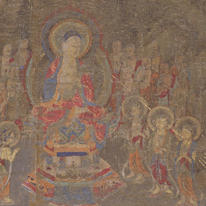Past Exhibitions
- Art of the Lotus Sutra and Shakyamuni
- April 14, 2015 - May 10, 2015
The Lotus Sutra is said to have been taught by Shakyamuni (Siddhartha Gautama) during his lifetime, but in fact was primarily compiled by Mahayana Buddhism adherents after his death. While the early Buddhist schools were heavily focused on seeking individual enlightenment, this approach was criticized by Mahayana Buddhism, which believed in the active pursuit of salvation for all. The Lotus Sutra teaches that all people have Buddha nature and can achieve salvation, but this was a highly radical idea at the time, and in the sutra itself there are recurring statements to the effect that "there are those who do not believe and would disparage this sutra, but it is the truth."
Encapsulating the very essence of Mahayana Buddhism, the Lotus Sutra was widely popular in Japan and lay at the root of New Kamakura Buddhism, which stressed the possibility of enlightenment for all. As such it inspired a great number of Buddhist paintings and had a great influence on the development of Japanese art.












